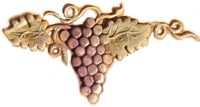OF WINE AND BAKING
The Swiss have been making wine since the Roman era. The earliest bottle was found near Valais, Switzerland in the Celtic tomb of a lady from 2nd Century B.C. Likewise, the Swiss have been baking confections using hand-carved wooden molds since at least the 14th Century.
Medieval European monasteries had a great history of viticulture and wine-making. With beehives commonly found in the vineyard, it's not surprising that baking molds were discovered that depict the vineyards, bees, harvests and wine-making.
HONEY IS THE CENTRE POINT
IN A GREAT CONVERGENCE OF WINE & BAKING
Thousands of years ago, people in the Indus Valley were imprinting honey cakes with clay molds. Later, Greeks and Egyptians imprinted their bread. The Romans brought this custom northwards, to the Rhine, where it likely influenced medieval European bakers.
Long before the advent of processed sugars like molasses, European bakers relied on honey to sweeten baked goods. Mead has been around for millennia, and the mazers (mead-makers) searched for honey that embodied the best reflection of local terroir. In the 16th Century, the gingerbread bakers of Torun were famed for their use of the highest quality flour and honey, which derived their unique taste from the forests and fields located along the Vistula river. Their gingerbread was formed into wonderful figures using hand-carved molds like the ones we use today.
Today there is renewed interest in the practice of keeping bees in the vineyards. Although they aren't needed to make grapes, the bees help to pollinate flowers and plants that grow around the vines, keeping the whole ecosystem healthy, and producing wonderful honey that reflects the nature of the vineyard.
Likewise, the baked confections offered by the Saffron Guild take full advantage of local honeys, which reflect the terroir of harvested pollen, just as the wine is an expression of place.
 MORE ON THE SAFFRON GUILD
MORE ON THE SAFFRON GUILD
In the Renaissance period, Europe's guilds stood on behalf of their members as a moderating force between church and state, and they became a driving force behind the great Reformation. Whittling away at the political power of bishops, the guilds became the personification of "town lord", supplanting both nobility and clergy.
Operating much like a secret society, the Saffron Guild furthered the business interests of its members and ensured high standards of both raw materials and the products and services produced from them.
Regular expenses of the Saffron Guild included costs to maintain the Guild House and the goods produced by members. At one point in time, guild dues were paid in the form of silver plates and cups – a trusted asset that could always be sold to carry them through hard times, if needed.
This practice is reflected today in a Swiss New Year's festival celebrated with wine, which pours out of a fountain at the foot of Cathedral Hill in Basel. To this day, Guild members arrive on New Year's morning to drink from the fountain, filling their silver cups with wine. At the appointed hour, guild representatives queue up, and pull silk pouches from their coat pockets that hold beautifully engraved silver cups.
The Safranzunft Guild House in Basel has been situated at various sites since the 14th century, but since 1902, the Safran Zunft has been located in the Gerbergasse quarter of Basel. Today it operates as a fine dining establishment, offering world class wines and cuisine. The main guildhall features an eight meter high vaulted ceiling, gorgeous stained glass and many historic features, with seating for 280 diners.

